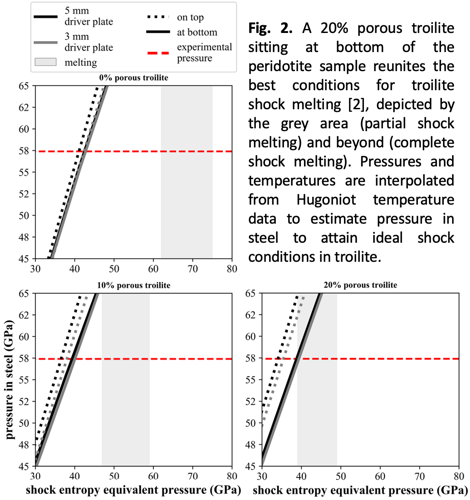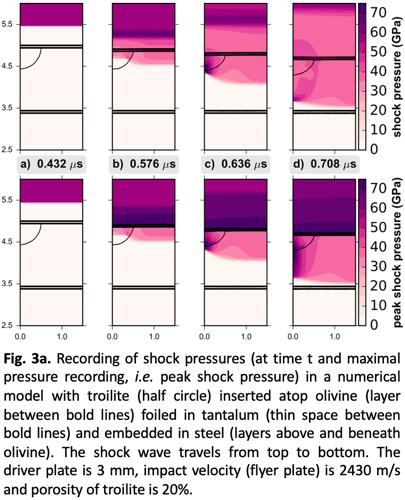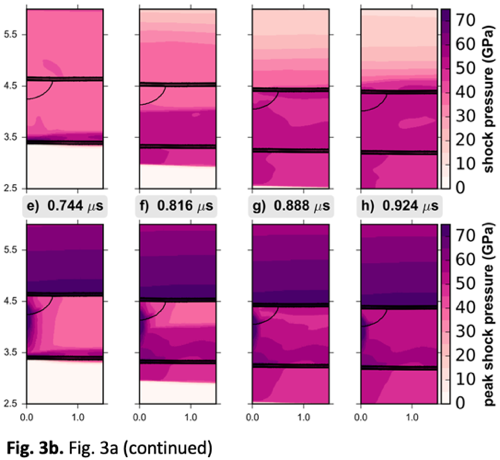- 1University of Tartu, Institute of Ecology and Earth Sciences, Dept. of Geology, Estonia (juulia.moreau@ut.ee)
- 2Institut für Planetologie, Universität Münster, Germany
- 3Geological Survey of Finland
Introduction: We present a shock-recovery setup to study the melting of genuine troilite and its migration into the surrounding silicate host [1-4], a process responsible for optical darkening in ordinary chondrites [5-6] between 40-60 GPa [3]. We combine a numerical approach [7] with a reverberation shock-recovery experiment [7-10] to calibrate our experimental requirements and verify or falsify our numerical results predictions. Because shock-recovery experiments are expensive, numerical models allow us to identify the optimum experimental conditions. Moreover, natural (precious) meteoritic samples do not allow for an all-parameter controlled experimental set-up, many phases can interact in shock settings [2-4], e.g., the eutectic properties of troilite change when Fe-metal is present [11], affecting the troilite melting efficiency.
Our work aims at identifying shock darkening enhancing parameters by using numerical models to narrow down experimental parameters to an ideal setup. We do this by using olivine and troilite minerals only, thus disposing of chondritic materials. Moreover, the simplification of the starting mineral setup (peridotite and troilite) ensures an uncorrupted study of the genuine melt behavior of troilite.
By succeeding shock melt migration of troilite, we aim to characterize the melt using various analytical methods. The experimental run products will be investigated by scanning electron microscopy, electron microprobe analyses, spectral analyses, x-ray tomography, and optical microscope observations. Identifying melt production and migration relevant parameters will improve our understanding of shock metamorphism and shock-darkening processes.
Methods: The outline of the shock experiment is summarized in Fig. 1. The sample consists of a 20 mm × 1.5 mm thick peridotite disk (Tulppio, Finland; Fo91). Previously synthesized powdered troilite (FeS, [12]) is filled into sub-mm drilled holes atop or beneath the peridotite disk. Powdered troilite promotes shock melting by pore crushing [2].
In classic shock-recovery experiments [8,9] a steel flyer plate (2 mm thick) is accelerated towards a steel container containing the sample. The shock wave propagates in sample after passing a 3 mm thick steel interface (driver plate). Reverberations occurring at bottom/top interfaces between sample and steel container equalize pressures in sample to the pressure in steel. A tantalum foil is used to protect the sample from iron contamination from the sample container.
Using the shock physics code iSALE-2D [13], we reproduce this setup: a half-disk of olivine for simulating peridotite (ANEOS for Fo90) with a 0.5 mm half-sphere of troilite (Tillotson EoS, [2]) surrounded by 0.06 mm thick tantalum (Tillotson EoS, [7]), all inserted in steel (ANEOS for iron) with the 3 mm thick steel driver plate above, are hit by a 2 mm thick steel flyer plate. We vary the impact velocity of the flyer plate (2000–2800 m/s), the troilite porosity (0–20%), its position in olivine (on top, at bottom) and record the following: pressure and temperature at nominal input (before reverberation) and peak of the shock (after reverberation) for olivine and troilite. We interpolate pressure and temperature values with Hugoniot data and estimate the effective entropy input from the reverberation in pressure units.

Expected results: The best conditions to induce melting of troilite are summarized in Fig. 2. A more in-depth illustration of the shock-wave propagation in the numerical models is shown in Fig. 3a-b. We estimate that a 20% porous troilite powder is necessary to induce melting of troilite upon release of the shock wave [2]; for good measure, we compared results for a 3- and 5-mm thick driver plate. We also observed that it is more efficient to melt 20% porous troilite that sits beneath the olivine disk. By observing the propagation of the shock wave, we see that reflected shock waves (first from bottom, lastly from top of the sample) which interfere with previous initial shock waves result in equalization of the pressure to the initial pressure in steel.


Outlook: The numerical study helps to set up optimum experimental conditions of the shock experiment in terms of phase positions within the sample (troilite top or bottom placement) and sample composition. With the planned experiment, we hope to observe shock-darkening of the troilite/peridotite assemblage, which will help to provide leads on similar processes observed in ordinary chondrites.
References:
[1] Stöffler et al. (2018) Meteorit. Planet. Sci. 53, 5–49. [2] Moreau et al. (2018) Phys. Earth Planet. In., 282, 25-38. [3] Moreau et al. (2019) Icarus, 332, 50-65. [4] Moreau and Schwinger (2020) Phys. Earth Planet. In., 310, 106630. [5] Kohout T. et al. (2014) Icarus, 228, 78-85. [6] DeMeo F. E. and Carry R. P. (2014) Nature, 505, 629-634. [7] Moreau (2019) Ph.D. thesis, Unigrafia, Helsinki, 60 pp. hdl.handle.net/10138/300084. [8] Langenhorst and Deutsch (1994) Earth Planet. Sci. Lett. 125, 407–420. [9] Langenhorst and Hornemann (2005) EMU Notes Mineral. 7, 357–387. [10] Schmitt (2000) Meteorit. Planet. Sci., 35(3), 545-560. [11] Mare et al. 2014) Meteorit. Planet. Sci. 49, 636–651. [12] Moreau et al. (2021) Meteorit. Planet. Sci., in prep. [13] Wünnemann K. et al. (2006) Icarus, 180, 514-527.
How to cite: Moreau, J.-G., Stojic, A. N., Jõeleht, A., Plado, J., and Hietala, S.: A shock-recovery experiment to study shock melting of troilite in ordinary chondrites, Europlanet Science Congress 2021, online, 13–24 Sep 2021, EPSC2021-34, https://doi.org/10.5194/epsc2021-34, 2021.

